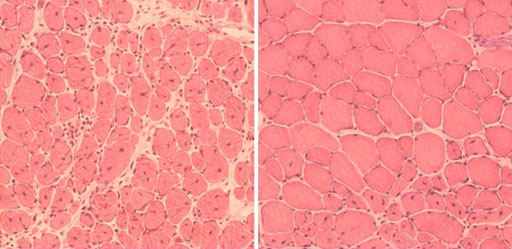Reprogramming Therapy Reverses Signs of Aging in Mouse Progeria Model
By LabMedica International staff writers
Posted on 28 Dec 2016
Researchers on the biology of aging have shown that when the type of cellular reprogramming used to produce pluripotent stem cells is applied intermittently to whole animals the aging process can be arrested or reversed without stimulating cancer development.Posted on 28 Dec 2016
In vitro studies have demonstrated that cellular reprogramming to pluripotency reverses cellular age, but alteration of the aging process through reprogramming has not been directly demonstrated in living animals.

Image: Induction of reprogramming improved muscle regeneration in aged mice. (Left) impaired muscle repair in aged mice; (right) improved muscle regeneration in aged mice subjected to reprogramming (Photo courtesy of the Salk Institute for Biological Studies).
To extend cellular reprogramming to whole animals while avoiding the completely uncontrolled type of growth that could lead to tumor development, investigators at the Salk Institute for Biological Studies (La Jolla, CA, USA) chose to work with a mouse progeria model. Animals with progeria show many signs of aging including DNA damage, organ dysfunction, and dramatically shortened lifespan.
To nullify the cancer threat, the investigators decided to induce partial reprogramming by short-term cyclic expression of the OSKM or Yamanaka reprogramming factors: Oct4 (octamer-binding transcription factor 4), Sox2 (SRY (sex determining region Y)-box 2), Klf4 (Kruppel-like factor 4), and c-Myc.
The investigators reported in the December 15, 2016, online edition of the journal Cell that partial reprogramming by short-term cyclic expression of the OSKM factors ameliorated cellular and physiological hallmarks of aging and prolonged lifespan by about 30% in the mouse progeria model. Similarly, expression of OSKM in vivo improved recovery from metabolic disease and muscle injury in older wild-type mice.
"Our study shows that aging may not have to proceed in one single direction," said senior author Dr. Juan Carlos Izpisua Belmonte, a professor in the gene expression laboratory at the Salk Institute for Biological Studies. "It has plasticity and, with careful modulation, aging might be reversed. Obviously, mice are not humans and we know it will be much more complex to rejuvenate a person. But this study shows that aging is a very dynamic and plastic process, and therefore will be more amenable to therapeutic interventions than what we previously thought."
The investigators warned that due to the complexity of aging in humans, potential anti-aging therapies based on these studies in mice may take up to 10 years to reach clinical trials.
Related Links:
Salk Institute for Biological Studies













